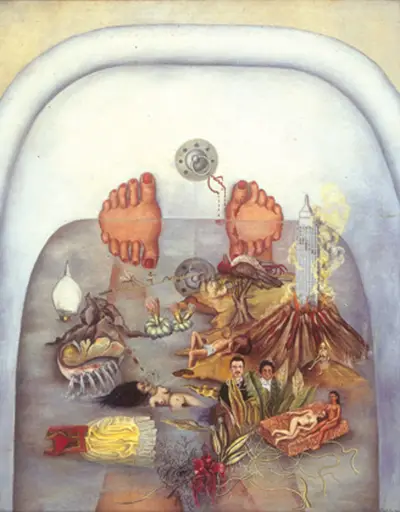It is oil on canvas, with of dimensions 91 x 70.5 cm (35.8 x 27.7"). The piece is a reflection of the artist's life, and depicts various images arising from grey bathwater, under which her legs and feet are visible. What the Water Gave Me was depicted in Kahlo's first solo exhibit at the Julien Levy Gallery in New York City in 1938. In a conversation with Levy, she said that the painting was an image of the passing of time, reflecting childhood games in the bathtub and the sadness of what had happened to her in the course of her life. Although she has often been considered a Surrealist, Kahlo herself rejected this description, saying: "They thought I was a Surrealist, but I wasn't. I never painted dreams. I painted my own reality."
Kahlo's distinctive style is recognisable in this work. However, unlike many of her other paintings, there is no central focus to the image. The clearly defined imagery contrasts to the scattered composition of the elements. We understand that the different elements attest to the immense suffering and trauma that Kahlo suffered, and the ambiguous feelings she had about her life's trajectory.
The depiction of Kahlo's own legs in a bath in What the Water Gave Me also confronts the problem of the female body usually being depicted as an object of the male gaze. Here, her body is the object of her own gaze. There is sexual imagery in the painting, but it represents Kahlo's sexuality as she herself considers it, rather than rendering it pleasing to the viewer's eye. It has belonged to the private collection of Daniel Filipacchi, a Surrealist art collector, for more than two decades. Despite limited accessibility for public viewing, it is a crucial piece in understanding the development of Kahlo's thought, as well as her skill and technique as an artist.

